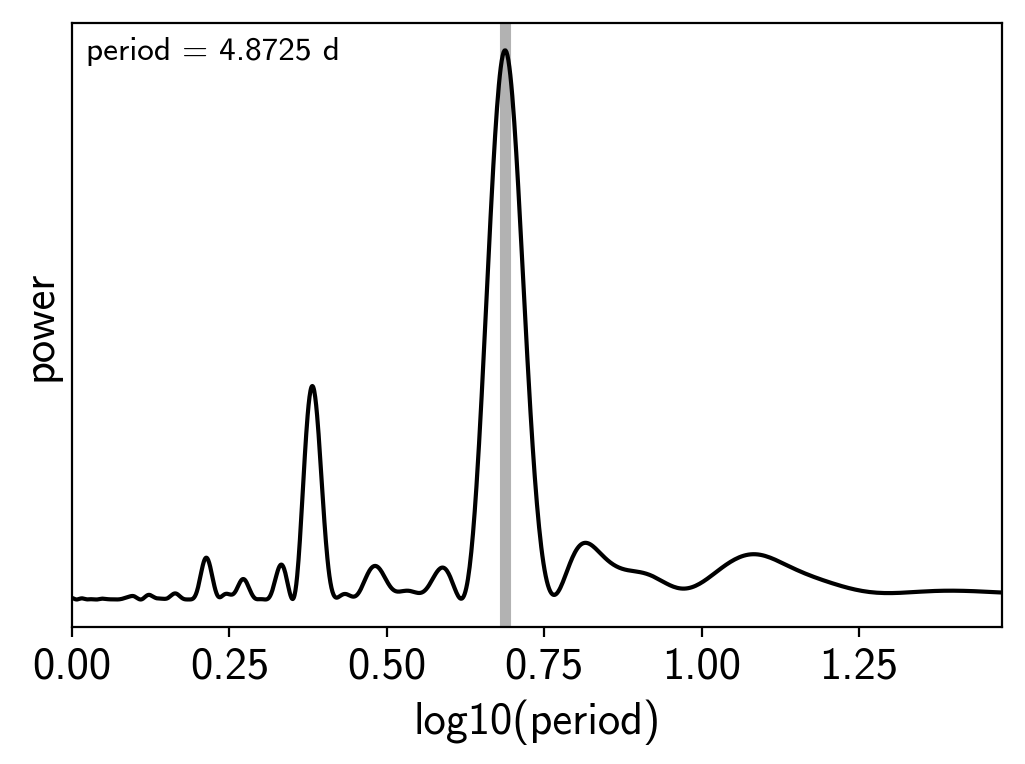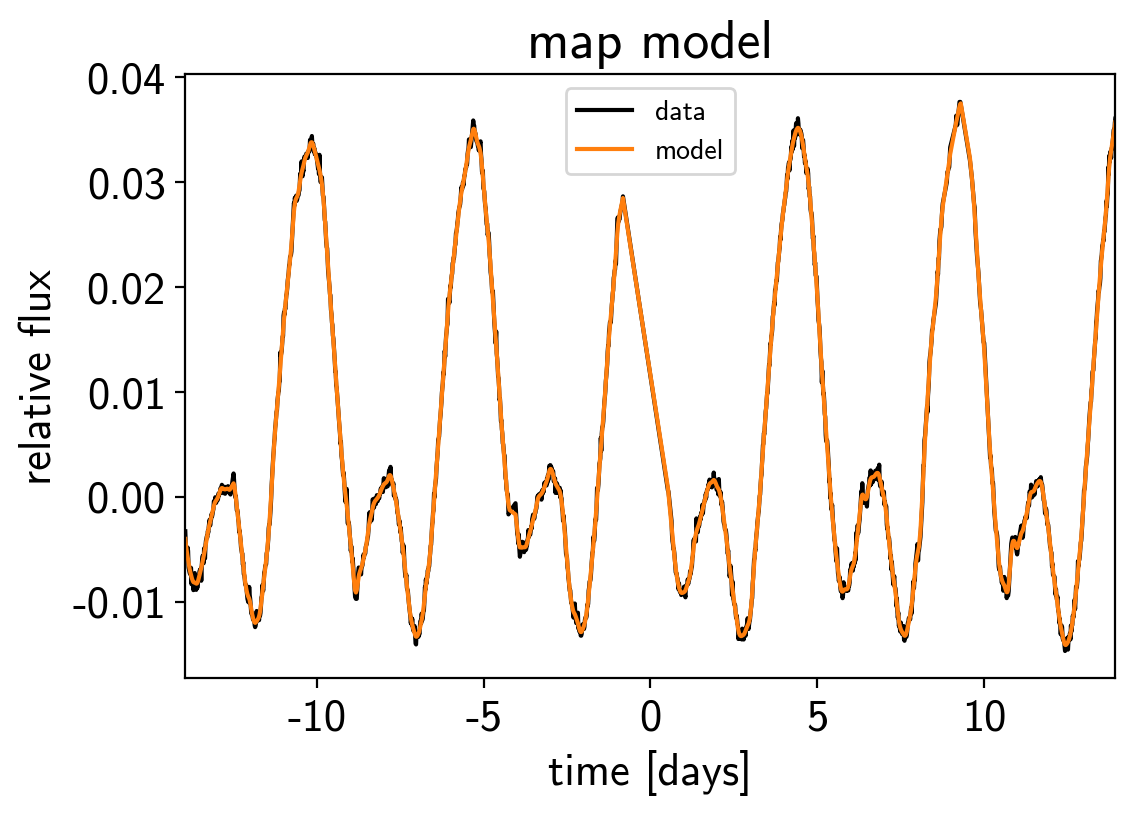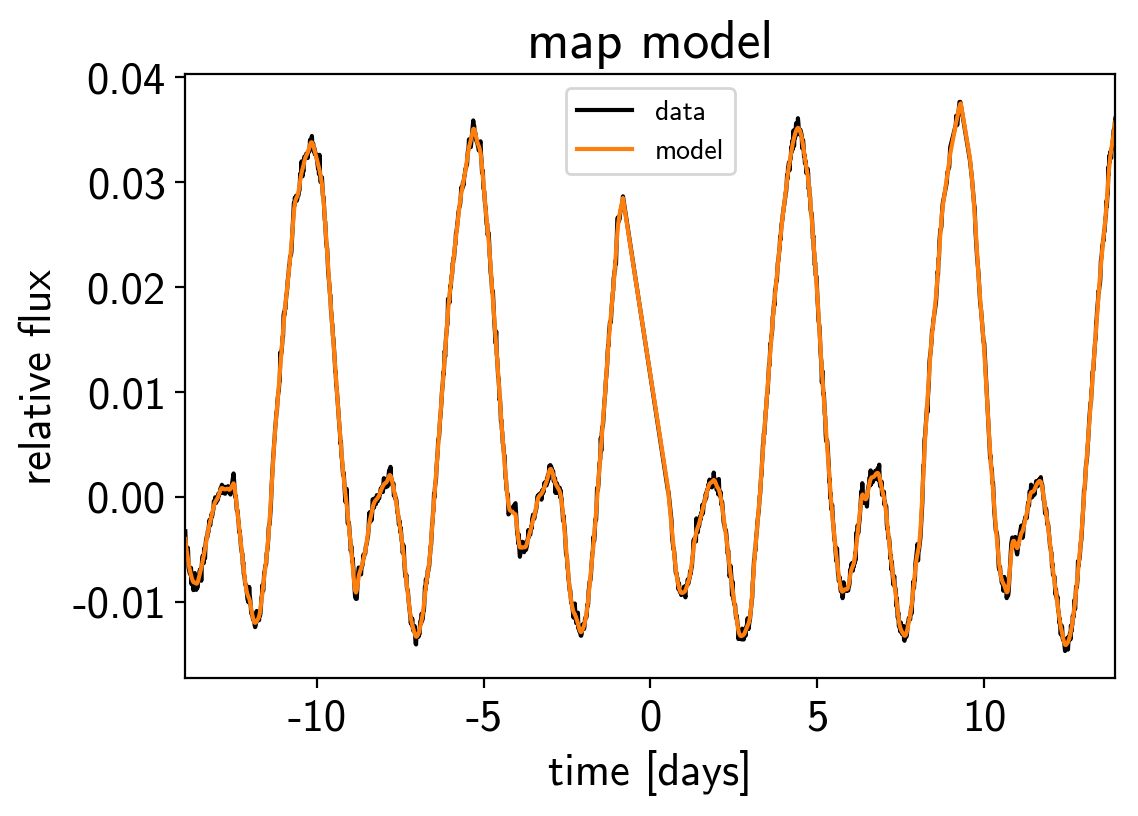Note
This tutorial was generated from an IPython notebook that can be downloaded here.
import numpy as np
from astropy.io import fits
import matplotlib.pyplot as plt
from scipy.signal import savgol_filter
lc_url = "https://archive.stsci.edu/missions/tess/tid/s0001/0000/0004/4142/0236/tess2018206045859-s0001-0000000441420236-0120-s_lc.fits"
with fits.open(lc_url) as hdus:
lc = hdus[1].data
lc_hdr = hdus[1].header
texp = lc_hdr["FRAMETIM"] * lc_hdr["NUM_FRM"]
texp /= 60.0 * 60.0 * 24.0
time = lc["TIME"]
flux = lc["PDCSAP_FLUX"]
flux_err = lc["PDCSAP_FLUX_ERR"]
m = np.isfinite(time) & np.isfinite(flux) & (lc["QUALITY"] == 0)
time = time[m]
flux = flux[m]
flux_err = flux_err[m]
# Identify outliers
m = np.ones(len(flux), dtype=bool)
for i in range(10):
y_prime = np.interp(time, time[m], flux[m])
smooth = savgol_filter(y_prime, 301, polyorder=3)
resid = flux - smooth
sigma = np.sqrt(np.mean(resid**2))
m0 = np.abs(resid) < sigma
if m.sum() == m0.sum():
m = m0
break
m = m0
# Just for this demo, subsample the data
ref_time = 0.5 * (np.min(time[m])+np.max(time[m]))
time = np.ascontiguousarray(time[m][::10] - ref_time, dtype=np.float64)
flux = np.ascontiguousarray(flux[m][::10], dtype=np.float64)
flux_err = np.ascontiguousarray(flux_err[m][::10], dtype=np.float64)
mu = np.median(flux)
flux = flux / mu - 1
flux_err /= mu
x = time
y = flux
yerr = flux_err
plt.plot(time, flux, ".k")
plt.plot(time, smooth[m][::10] / mu - 1);

import exoplanet as xo
results = xo.estimators.lomb_scargle_estimator(
x, y, max_peaks=1, min_period=1.0, max_period=30.0,
samples_per_peak=50)
peak = results["peaks"][0]
ls_period = peak["period"]
freq, power = results["periodogram"]
plt.plot(-np.log10(freq), power, "k")
plt.axvline(np.log10(ls_period), color="k", lw=4, alpha=0.3)
plt.xlim((-np.log10(freq)).min(), (-np.log10(freq)).max())
plt.annotate("period = {0:.4f} d".format(ls_period),
(0, 1), xycoords="axes fraction",
xytext=(5, -5), textcoords="offset points",
va="top", ha="left", fontsize=12)
plt.yticks([])
plt.xlabel("log10(period)")
plt.ylabel("power");

import pymc3 as pm
import theano.tensor as tt
def build_model(mask=None):
if mask is None:
mask = np.ones_like(x, dtype=bool)
with pm.Model() as model:
# The mean flux of the time series
mean = pm.Normal("mean", mu=0.0, sd=10.0)
# A jitter term describing excess white noise
logs2 = pm.Normal("logs2", mu=2*np.log(np.min(yerr[mask])), sd=5.0)
# A SHO term to capture long term trends
logS = pm.Normal("logS", mu=0.0, sd=15.0, testval=np.log(np.var(y[mask])))
logw = pm.Normal("logw", mu=np.log(2*np.pi/10.0), sd=10.0)
term1 = xo.gp.terms.SHOTerm(log_S0=logS, log_w0=logw, Q=1/np.sqrt(2))
# The parameters of the RotationTerm kernel
logamp = pm.Normal("logamp", mu=np.log(np.var(y[mask])), sd=5.0)
logperiod = pm.Normal("logperiod", mu=np.log(ls_period), sd=5.0)
period = pm.Deterministic("period", tt.exp(logperiod))
logQ0 = pm.Normal("logQ0", mu=1.0, sd=10.0)
logdeltaQ = pm.Normal("logdeltaQ", mu=2.0, sd=10.0)
mix = pm.Uniform("mix", lower=0, upper=1.0)
term2 = xo.gp.terms.RotationTerm(
log_amp=logamp,
period=period,
log_Q0=logQ0,
log_deltaQ=logdeltaQ,
mix=mix
)
# Set up the Gaussian Process model
kernel = term1 + term2
gp = xo.gp.GP(kernel, x[mask], yerr[mask]**2 + tt.exp(logs2), J=6)
# Compute the Gaussian Process likelihood and add it into the
# the PyMC3 model as a "potential"
pm.Potential("loglike", gp.log_likelihood(y[mask] - mean))
# Compute the mean model prediction for plotting purposes
pm.Deterministic("pred", gp.predict())
# Optimize to find the maximum a posteriori parameters
map_soln = pm.find_MAP(start=model.test_point, vars=[mean, logs2])
map_soln = pm.find_MAP(start=map_soln, vars=[mean, logs2, logS, logw])
map_soln = pm.find_MAP(start=map_soln, vars=[mean, logs2, logamp, logQ0, logdeltaQ, mix])
map_soln = pm.find_MAP(start=map_soln)
return model, map_soln
model0, map_soln0 = build_model()
logp = 10,197, ||grad|| = 0.00043711: 100%|██████████| 13/13 [00:00<00:00, 324.72it/s]
logp = 10,202, ||grad|| = 65.929: 100%|██████████| 20/20 [00:00<00:00, 258.96it/s]
logp = 10,213, ||grad|| = 270.28: 100%|██████████| 51/51 [00:00<00:00, 269.75it/s]
logp = 10,213, ||grad|| = 6.8898: 100%|██████████| 8/8 [00:00<00:00, 273.82it/s]
plt.plot(x, y, "k", label="data")
plt.plot(x, map_soln0["pred"] + map_soln0["mean"], color="C1", label="model")
plt.xlim(x.min(), x.max())
plt.legend(fontsize=10)
plt.xlabel("time [days]")
plt.ylabel("relative flux")
plt.title("map model");

mod = map_soln0["pred"] + map_soln0["mean"]
resid = y - mod
rms = np.sqrt(np.median(resid**2))
mask = np.abs(resid) < 7 * rms
plt.plot(x, resid, "k", label="data")
plt.plot(x[~mask], resid[~mask], "xr", label="outliers")
plt.axhline(0, color="#aaaaaa", lw=1)
plt.ylabel("residuals [ppt]")
plt.xlabel("time [days]")
plt.legend(fontsize=12, loc=4)
plt.xlim(x.min(), x.max());

model, map_soln = build_model(mask)
logp = 10,197, ||grad|| = 0.00043711: 100%|██████████| 13/13 [00:00<00:00, 303.59it/s]
logp = 10,202, ||grad|| = 65.929: 100%|██████████| 20/20 [00:00<00:00, 246.44it/s]
logp = 10,213, ||grad|| = 270.28: 100%|██████████| 51/51 [00:00<00:00, 246.53it/s]
logp = 10,213, ||grad|| = 6.8898: 100%|██████████| 8/8 [00:00<00:00, 162.98it/s]
plt.plot(x[mask], y[mask], "k", label="data")
plt.plot(x[mask], map_soln["pred"] + map_soln["mean"], color="C1", label="model")
plt.xlim(x.min(), x.max())
plt.legend(fontsize=10)
plt.xlabel("time [days]")
plt.ylabel("relative flux")
plt.title("map model");

sampler = xo.PyMC3Sampler()
with model:
sampler.tune(tune=2000, start=map_soln, step_kwargs=dict(target_accept=0.9))
trace = sampler.sample(draws=2000)
Sampling 2 chains: 100%|██████████| 154/154 [00:45<00:00, 1.32draws/s]
Sampling 2 chains: 100%|██████████| 54/54 [00:13<00:00, 1.70draws/s]
Sampling 2 chains: 100%|██████████| 104/104 [00:13<00:00, 5.45draws/s]
Sampling 2 chains: 100%|██████████| 204/204 [00:50<00:00, 1.99draws/s]
Sampling 2 chains: 100%|██████████| 404/404 [00:27<00:00, 13.08draws/s]
Sampling 2 chains: 100%|██████████| 804/804 [04:54<00:00, 1.08s/draws]
Sampling 2 chains: 100%|██████████| 2304/2304 [06:59<00:00, 3.97draws/s]
Multiprocess sampling (2 chains in 2 jobs)
NUTS: [mix, logdeltaQ, logQ0, logperiod, logamp, logw, logS, logs2, mean]
Sampling 2 chains: 100%|██████████| 4100/4100 [16:32<00:00, 2.22draws/s]
period_samples = trace["period"]
plt.hist(period_samples, 35, histtype="step", color="k")
plt.yticks([])
plt.xlabel("rotation period [days]")
plt.ylabel("posterior density");
